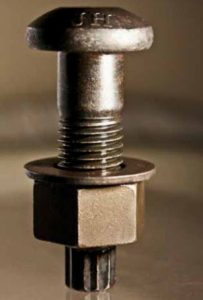
Tension control bolts play an important role in steel framing construction. From bridges and high-rise buildings to machinery and aircraft, they offer a strong and reliable fastening mechanism. Tension control bolts, however, aren’t ordinary bolts. They feature a spline that’s designed to snap off during installation.
What Are Tension Control Bolts?
Tension control bolts are a type of structural bolt for which the tension can be controlled. They have a domed head with a partially threaded shank. At the end of the shank is a nut and spline. With this unique design, you can control the tension of them.
How Tension Control Bolts Work
You’ll need a special type of tightening tool to install tension control bolts. Known as a shear wrench, this tool will break the spline after reaching the desired tension level.
Tension control bolts don’t have a traditional hex head like most other bolts. Instead, they have a smooth, rounded head. To install a tension control bolt, you’ll need to twist it into the threaded hole. Once in place, you twist the nut onto the end of the spline and shank.
Now it’s time to use the shear wrench. Shear wrenches have an inner socket and an outer socket. These sockets are designed to rotate in different directions. Upon reaching the desired tension, the spline will break off. The tension control bolt will then have a clean end consisting of the threaded shank with the attached nut.
Benefits of Tension Control Bolts
What are the benefits of tension control bolts exactly? For starters, you don’t have to worry about overtightening them and damaging the parts with which they are used. With tension control bolts, you can set the desired tension with the shear wrench. Once you reach this tension, the spline will snap off.
Tension control bolts are durable. They are often made of corrosion-resistant, high-strength steel. Tension control bolts are also easy to install. They can typically be installed by just a single worker, and the only tool required for installation is a shear wrench.
In Conclusion
For sensitive fastening applications that require a specific level of tension, you can’t go wrong with tension control bolts. They have a partially threaded shank with a spline on the end. When installing a tension control bolt, a shear wrench will snap off the spline once the desired tension has been reached.
